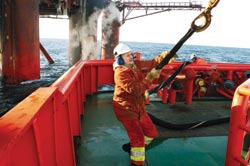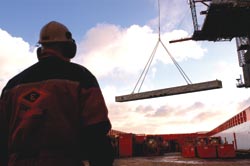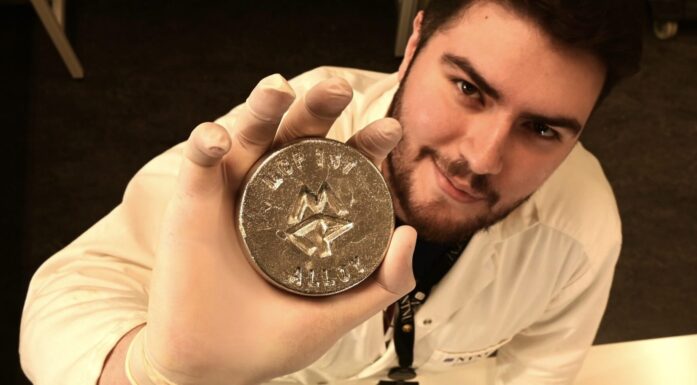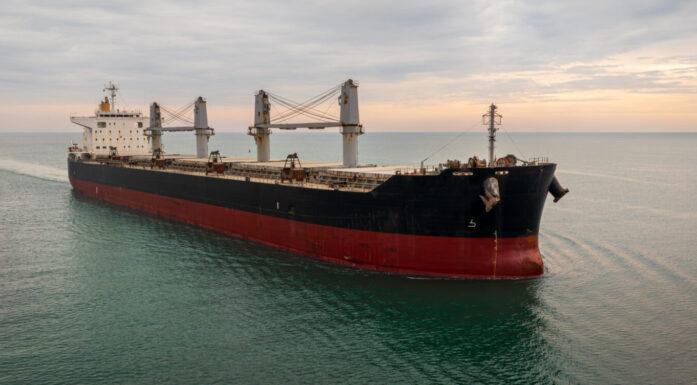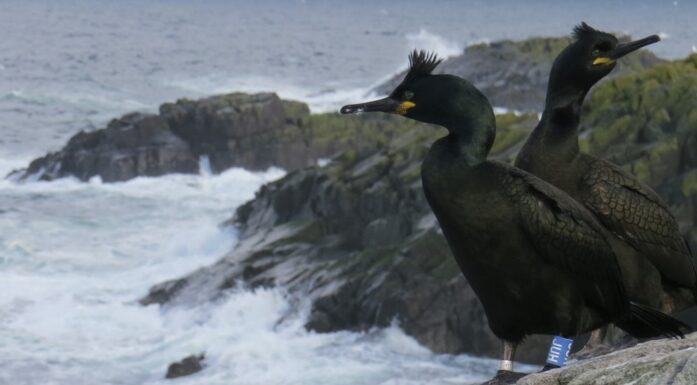The last cowboys of the sea
While security on Statoil’s oil rigs gets top marks, there were Wild West conditions on board the boats in the company’s service.
The stern of the 95-metre long vessel shoots high into the air before diving down into the waves again. We are in the Tampen-area, northwest of Bergen, and a ride on this supply boat, dubbed the Viking Energy, feels like a rollercoaster ride in slow motion. At the gunwale four metres above the deck able seamen Arne Sandvik and Gunnar Amland are waiting at the stern for the hoses from Kvitebjørn, one of Statoil’s oil rigs.
The hoses transfer drinking water and diesel fuel to the rig from the supply boat. Rough weather in the North Sea has forced the hardy Viking Energy to dock in Bergen for four days – a change from its normal routine of shuttling between land and the oil rigs. At five in the morning on a Friday, Statoil orders the crew to get ready for departure. The wind is about to subside, and it may be possible to get some work done by the afternoon. Just a few years ago a storm would not be enough to keep the boat’s crew from their journey to the rigs. Now, first mate Eivind Kallevåg and his colleagues on the bridge keep constant watch on the charts that continuously record wave height and wind velocity.
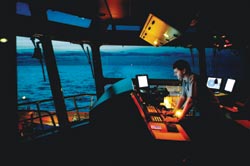
Photo: Paul Sigve Amundsen
From the bridge second mate Paul Atle Toft is responsible for boat and crew alike.
PERILOUS WORK
The crews on supply boats and the vessels that move oil rigs perform hundreds of tasks every day that demand their full attention, if accidents are to be avoided. The able seamen on board the Viking Energy are completely aware of this. The weather conditions are tricky, and the crew is fully concentrating on keeping their balance and avoiding being struck by the heavy couplings that connect the hoses. From the wheel house, Kallevåg supervises the work and listens to the radio communication between the crane operator on the oil rig and the able seamen on deck.
“This is the most risky of our tasks. The waves cause the boat to tilt up and down by several meters in only a few seconds, making it hard for the crane operator to determine how far down to lower the hose,” he explains.
ENTER THE RESEARCHERS
For a long time, Kallevåg and his colleagues were known as the ‘last cowboys’. They had the dubious honour of belonging to the group of workers with the highest rate of injures in the Norwegian oil and gas industry. The bleak statistics showed 12 consecutive years of fatal accidents.
The number of injuries and collisions between vessels and rigs had also increased dramatically over the course of a few years, until Statoil decided it was time to reverse the trend in 2002. By 2004, the red numbers have almost disappeared . Instead of asking engineers to solve the problem, Statoil hired researchers, educated in psychology and social anthropology, from Studio Apertura at NTNU. The assignment given to Trond Kongsvik and Rolf Bye, along with a PhD student from Marintek, Lisbeth Hansson, was concise: reduce the injury statistics as quickly as possible.
“Several studies have shown that about 80% of all transportation accidents are caused by human error. For us the first step was to talk to the employees. We also studied the statistics carefully before carrying out a survey about work environment and conditions.”
The survey response from the crew of all 35 vessels was strong, and the researchers immediately identified several problem areas. Heightened demands from Statoil to increase efficiency turned out to be one of the greatest challenges to safety. In the year after the study was completed, Statoil initiated a number of actions to fix the security problems:
- An additional mate was put on duty each shift, ensuring two navigators on the bridge at all times
- All supply boats were required to dock and rest one day a week
- Stricter regulations were imposed on noise levels
- Statoil and the various shipping companies agreed to meet regularly
Two years later, after another survey, the attitude towards Statoil as an employer had already changed dramatically. From ranking as the worst in security of all the oil companies on the Norwegian section of the Continental Shelf, Statoil now claimed a place in the lead.
“Often, when security is on the agenda, the inclination is to resort to technical gadgets.We approached the problem by cooperating with the people who are affected by it, and assessed the situation from a more organizational point of view,” Kongsvik explains.
The two researchers have kept in constant contact with the ‘owners’ of the problems found in the logistical chain. The pair has arranged conferences where the parties have evaluated the results of the survey and have come up with possible solutions to improve the situation.
A PINCHED FINGER
Viking Energy was built on commission from Statoil, when the debate about security was at its most heated, and was launched in April of 2003. It has become a model supply boat, both in terms of its technical solutions and comfort. It runs so quietly that you can hear your neighbour think. The survey showed that the crew considered lack of sleep one of the greatest risks to security. A shift rotation based on a continuous 6-hour-on, 6-hour-off schedule, as well as noise from propellers and rough weather, never allowed for enough rest. “On a boat where I worked previously, tests proved that even our cabins were noisy enough to require ear protection,” says second mate Paul Atle Toft.
He has worked as second mate for years, but has never experienced any serious incidents first hand. He claims this is due to luck rather than good work conditions.
“We used to work two days in a row some times. For the last few hours you’d simply feel deliriously drunk. Now there are more boats, fortunately, and more people to do the work.”
There are no horror stories from Viking Energy’s first year at sea, but most of the men know what it means to risk their life on the job. Captain Einar Svendsen had second-hand experience with the last fatal accident on one of Statoil’s boats. Even though he was off duty when a colleague was killed, he found it tough to get back to work because he knew the colleague well. He is very pleased that his own safety reports have registered a pinched finger as the most serious injury on board.
IMPROVED ATTITUDES
Security on oil rigs has been strong for a number of years. Last year, the vessels that service the rigs reached this same level of security. Thormod Hope is director of safety alert stand-by, maritime operations, and air transport for Statoil. He admits that the communication between Statoil and the boats was so bad that the company didn’t know what kinds of problems caused many of the accidents.
“From experience we knew that problems with safety often originate from work conditions in general, but we had never asked for any feedback from the crews on the boats,” Hope explains. Statoil’s safety project is planned for completion by the end of 2004, and the last questionnaires on work conditions are currently being sent out.
THE PRESSURE IS OFF
On deck, the able seamen are finishing up with the hoses. For the most part, they feel safe at work, but today none of them are pleased with the conditions.
“It’s not great standing on the stern in weather like this, especially not when the crane operator isn’t among the best,” says Arne. One hundred and containers are now due to be hoisted from the deck onto the oil rigs. The crew on Viking Energy know that some of the equipment needs to be delivered fast, but instead of increasing the work tempo for just a few boats, Statoil has hired extra boats to make up for lost time. According to the last study, which dates from 2002, most crew members regarded security as the first priority at Statoil. Still, many felt that the company pressured boats to work even if conditions were bad. A new survey was carried out in 2004, but the data is still being analysed. Captain Svendsen says he sees that security has truly become a prime concern at Statoil.
“In ninety percent of the cases the oil rigs call the operation off. Ten years ago there was much more pressure to go for it and keep trying, even if we thought it wasn’t safe. I think we have a good dialogue with Statoil, and today there is never a problem if we say we must wait. It seems like there has been a change in attitude.”
Elin Fugelsnes
COLLISIONS AND INJURIES
- In 1996, there was one collision between vessel and rig. Four years later the number had risen to 12. For the last three years the number of collisions has again dropped to one per year.
- The number of injuries doubled from 1996 to 2001, from 13 to 26. In 2003, the number dropped to 12.
- Since 2001, there have not been any fatal accidents or debilitating injuries. The number of injuries re quiring first aid was also halved from 2001 to 2003.
- EA psychologist and a social anthropologist from NTNU have contributed to putting safety first again.
